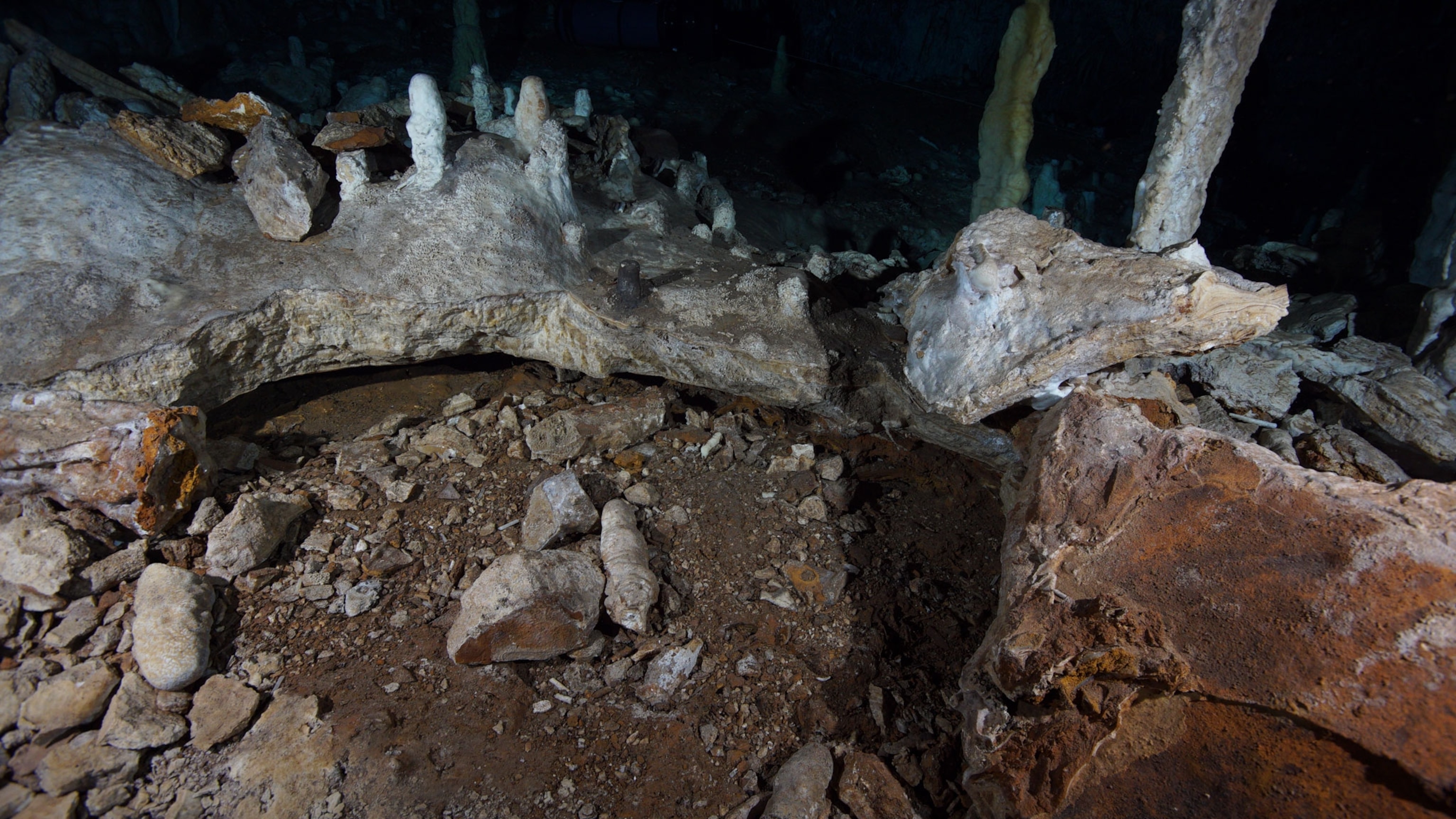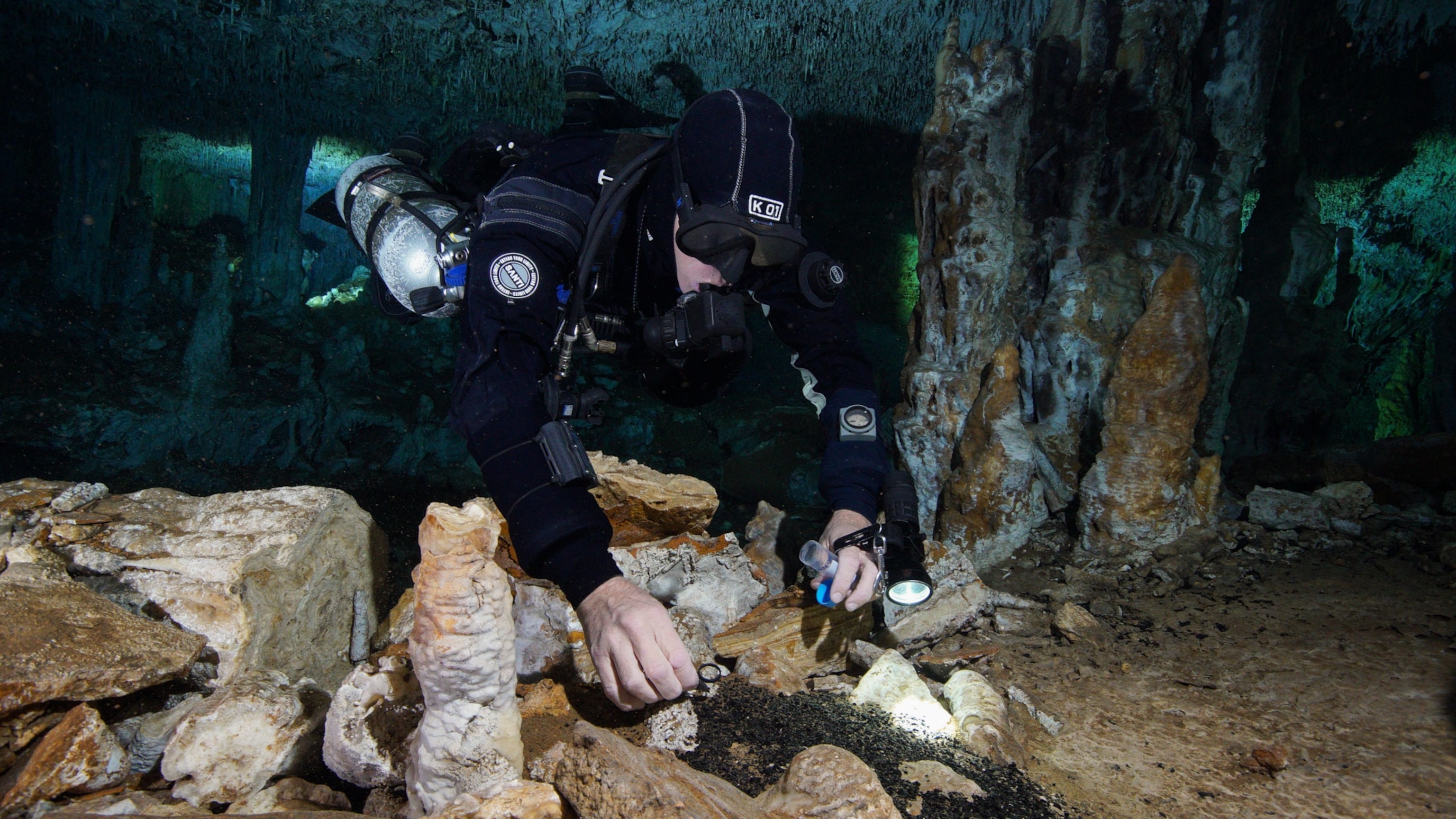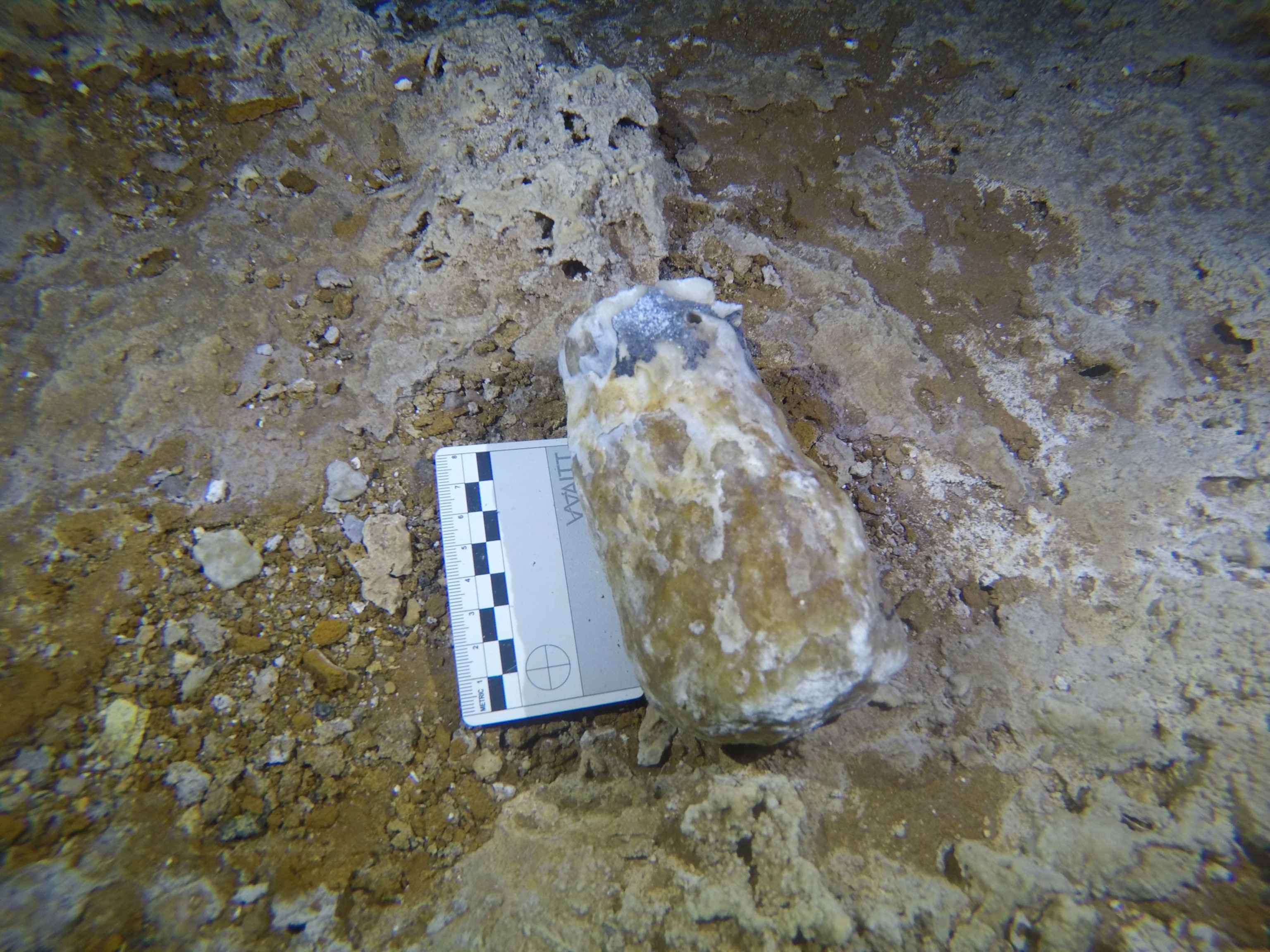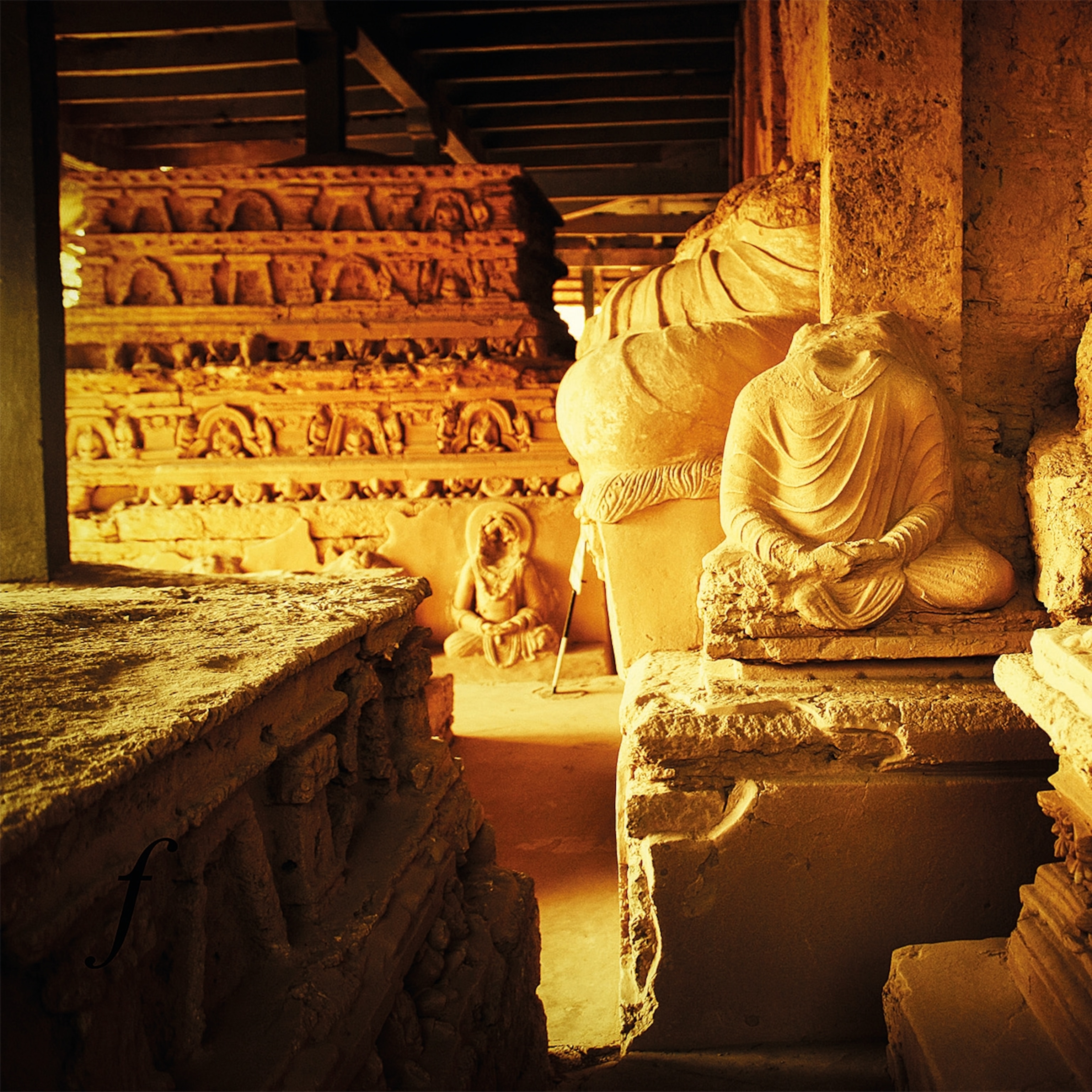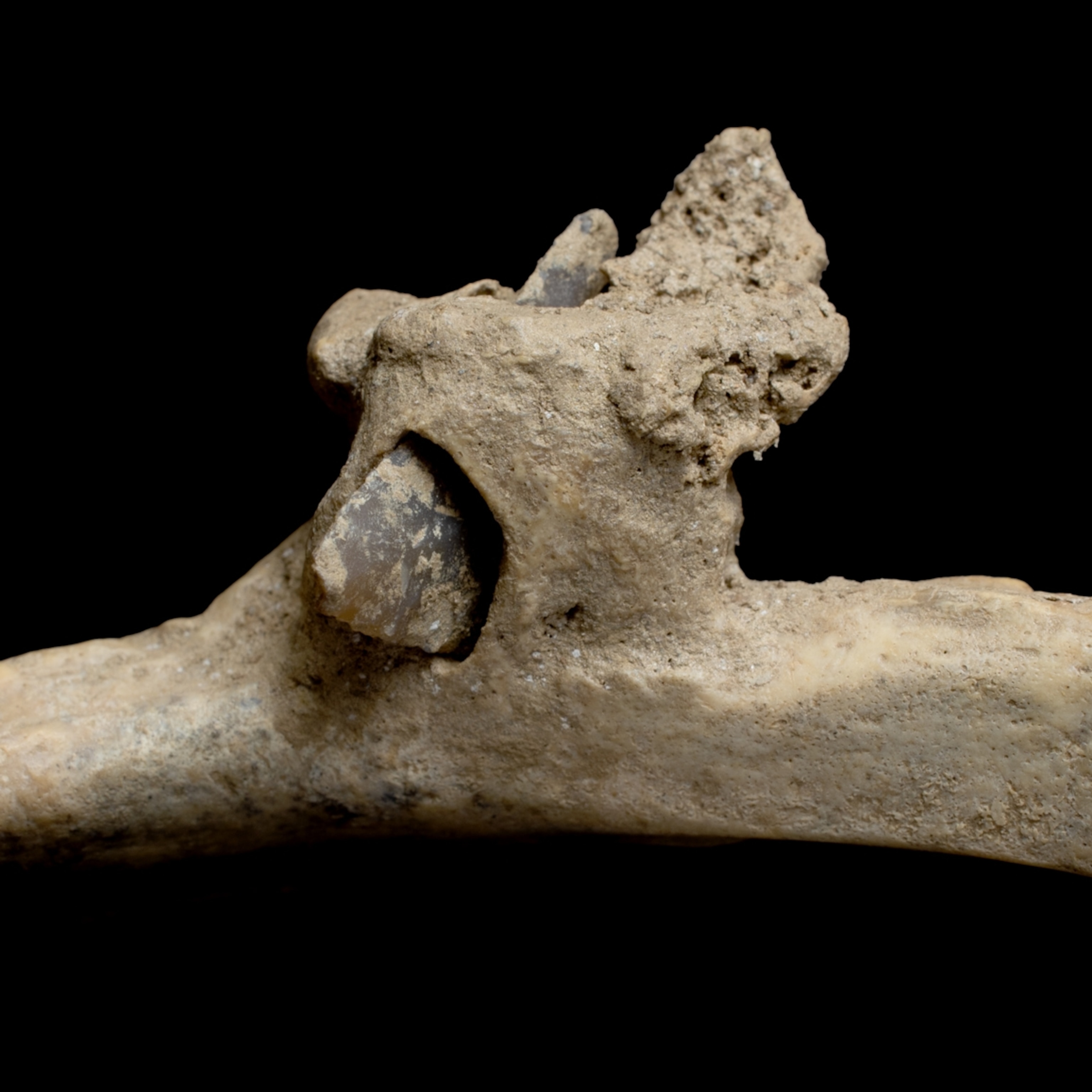11,000-year-old mine in underwater cave surprises archaeologists
The ancient site, preserved like a time capsule deep in a Mexican cave system, gives a rare glimpse into the lives and actions of some of the first residents of the Americas.
In the spring of 2017, a pair of divers shimmied fin-first through a narrow passageway in a water-filled cave beneath Mexico’s Yucatán peninsula. They had already swum for nearly half a mile through the cave system, winding around spires of rock jutting from the ceiling and floor, when they finally arrived at the threshold that spanned a mere 28 inches across.
“That was the portal into this whole other side,” recalls one of the divers, Sam Meacham, director of the Quintana Roo Aquifer System Research Center (CINDAQ).
In the chamber that lay beyond the tiny passage was an ancient scene preserved in stunning detail: an 11,000-year-old mining site for red ocher pigments, complete with tools and fire pits. The mine, described in a new study published today in Science Advances, is one of the few archaeological sites to reveal where and how ancient humans extracted the vibrant pigments that have been put to a host of uses around the world, including mortuary rituals, cave painting, and even sunscreen.
“I’ve spent a lot of time imagining the different ways that people in the past have gone about collecting mineral pigments,” says study author Brandi MacDonald, an archaeologist at the University of Missouri and expert on ocher pigments. “But being able to see it like this in such an interesting state of preservation, it just kind of blew me away.”
The discovery also gives a rare glimpse into the lives of some of the first residents of the Americas, who lived in Yucatán thousands of years before the rise of the ancient Maya state. One of these earliest inhabitants was a girl archaeologists named Naia, who likely fell to her death in another cave near the newfound mine some 13,000 years ago. At least nine other ancient individuals have been identified in the tangled system of caves beneath Quintana Roo, their remains preserved for thousands of years after the caves flooded from rising seas roughly 8,000 years ago.
But scientists still debate what people were doing deep inside this dark underworld. Were they burying their dead? Seeking sources of fresh water?
“What the hell were they going down there for?” says Roberto Junco, director of the Underwater Archaeology office of the National Institute of Anthropology and History (INAH), the regulating body for archaeology in Mexico. “Now we have really, really strong evidence that at least one of the reasons...was for the mining of ocher.”
Venture into the darkness
The discovery of the mine began with a happenstance find when students in a cave surveying class led by Fred Devos, a cave diver with CINDAQ, spotted a previously unnoticed tunnel while diving in the Sagitario cave system. Devos and Meacham returned soon after to explore. After a lengthy swim and squeeze through the narrow passageway, the divers were astonished by what they saw.
The site is a time capsule of human activity: Pits pockmark the chamber floor, and scattered across are broken speleothems—stalagmites or stalactites—that had been used as makeshift hammers. Burnt rock and charcoal remained from fires that once illuminated the cavern, and tidy piles of rock, known as cairns, marked the miner’s way.
“Fred and I immediately just started pointing at all of this stuff,” Meacham says. “It’s not natural, and there’s nothing that could have done this other than humans.”
Devos reached out to Eduard Reinhardt, a geoarchaeologist at McMaster University to discuss the site. While Reinhardt was initially skeptical, he headed down to Mexico the following year to dive through the section of cave with artifacts, which was later named La Mina (“the mine.”) “The site is phenomenal,” Reinhard says.
What’s more, the mining wasn’t just limited to the one cave.
During past dives, Meacham says, “We’ve noticed these strange, out-of-place things,” including rocks stacked into piles and speleothems arranged on the cave floors. Yet with many people diving in Yucatán’s caves, there was always doubt as to whether these oddities came from ancient or modern activity, Reinhardt says.
Now, with such a pristine example of an ancient ocher mine in hand, the team was able to confirm that at least two other suspected sites in submerged caves some 20 miles south of La Mina in Quintana Roo were also likely mining operations. The trio of mines were in use between 10,000 and 12,000 years ago, according to radiocarbon dates.
“It’s not just a one-off sort of thing,” Reinhardt says. “There was an active program to prospect, find, and extract ocher. There’ll no doubt be more locations.”
Colorful connections
Teaming up with other scientists and divers, the research crew began documenting the ancient mining activity inside the identified sites. Across 100 dives totaling more than 600 hours underwater, the team collected samples and captured video, along with tens of thousands of photos to construct a three-dimensional model of the La Mina site. The analysis paints a colorful picture of well-planned expeditions underground by generations of people knowledgable of the landscape for some 2,000 years.
The charcoal found around the mines comes from high-resin woods, and was likely selected for its ability to burn bright and long, according to analysis by study author Barry Rock of the University of New Hampshire. The site also seems to preserve the ancient miners’ thought process on excavating materials, notes Reinhardt: The miners followed along the deposit beds until the ocher petered out. They then shifted sideways to dig another pit. “They understood...some basic geological principles that weren’t really codified or formalized until the mid 1600s,” he says.
The pigments themselves were also very high quality, MacDonald adds, with few impurities and a very fine grain size. This means it readily imparts its vibrant hues to everything it touches. “It stains like crazy,” she says.
Yet what exactly were the people doing with this abundance of pigment? Ocher is an iron-rich material that humans around the world have used for hundreds of thousands of years. The pigments were used to mix a vibrant slurry in abalone shells in South Africa around 100,000 years ago. They illuminate the outline of hands held up to cave walls in Chauvet, France some 30,000 years ago. They coat a woman buried in a cave in northern Spain some 19,000 years ago.
Ocher’s uses are also practical. It can act as a mosquito repellent or a sunscreen. It may have formed the base for adhesives in toolmaking. Some indigenous Africans and Australians still use these vibrant pigments today for both ritual and practical purposes.
However, for the people mining ocher in the caves of the Yucatán, the end goal remains unclear. “At this time, we just don’t know,” MacDonald says.
Why were they there?
Some scientists see clues in the mines themselves that might hint at a ritual or spiritual side of the find. The mining sites are located deep in underground systems, far from the reaches of light, says Holley Moyes of the University of California, Merced, who specializes in the ritual use of Maya caves and was not a part of the project. In almost every instance yet found through humankind’s early history, she says, uses of this so-called “dark zone” are limited to ritual purposes.
“Caves produce all kinds of good and evil; they’re probably the most sacred natural feature,” Moyes says. Viewed as entrances to the underworld and sources of sacred water, caves are particularly spiritual places for the Maya, who first built their towns and cities in Yucatán thousands of years after the mine was abandoned. Ocher was also sacred to the Maya and other Mesoamerican cultures, such as the Aztecs, and featured prominently in art and rituals. “It’s something about that red color,” she says.
Part of the challenge in understanding ancient actions stems from a modern separation of the spiritual and the practical, says James Brady, an expert in cave archaeology at California State University, Los Angeles, who was not part of the study team. For many people today, “religion is one hour on Sunday morning,” he says. But that was likely not the case thousands of years ago. “It could be highly significant that this came from a sacred place,” he says of the ocher, “[And] that there was a journey into the cave especially to get it.”
Regardless of the intent behind the extraction, researchers are thrilled about the find. The site’s astounding preservation provides an unprecedented window into the activities of the early residents of the Americas, and promises to help direct future research into the use of caves.
“We’re super excited here in Mexico to be working on this project,” INAH’s Junco says. “This is truly one of those moments where there’s a big change in the game.”


